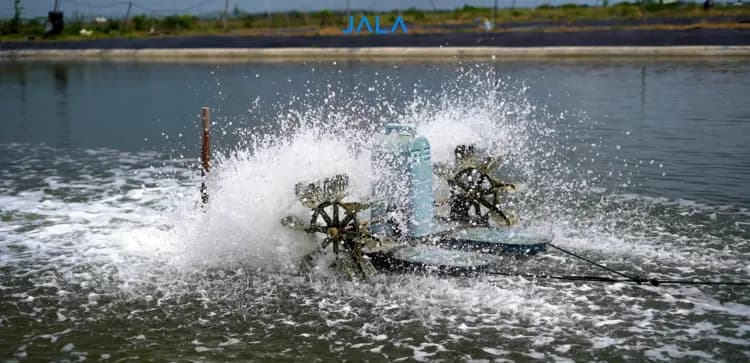
The success of shrimp cultivation heavily depends on having quality shrimp ponds. A pond with ideal conditions can support shrimp growth until harvest and help avoid failure risks due to diseases. What should farmers consider when maintaining the quality of shrimp ponds? Find out more in this article.
Types of Shrimp Ponds
There are several types of shrimp ponds depending on their shape and material. Here is the comparison of some types of shrimp ponds:
1. Square pond
Square ponds are suitable for environments with soil terrain, as the soil can help reinforce the pond walls. They can be used for all levels of farming intensification, from traditional to super-intensive. Additionally, the farm area can be maximized because square ponds can be built close together. If you choose to farm with square ponds, make sure they are well-protected to prevent abrasion.
2. Round pond
Round ponds are ideal for sandy areas because they are more resistant to abrasion. This type of pond is also suitable for household-scale cultivations that do not require large-sized ponds. In terms of stocking density, round ponds are suitable for intensive to super-intensive systems. A key advantage of round ponds is the absence of dead corners, allowing feed and treatments to be distributed evenly. However, the round shape makes it difficult to maximize production area. The absence of corners also causes the paddle wheel currents to push waste to the center, thus requiring more frequent cleaning.
3. Concrete pond
Concrete ponds are one type of shrimp pond based on its material. Concrete is a popular construction material because it is considered more robust and durable for farming. Additionally, using concrete can reduce soil subsidence due to water pressure and simplify the sterilization processes. It is important to note that this type of pond requires higher costs and longer construction times.
4. Tarpaulin pond
Tarpaulin ponds are more affordable to construct than concrete ponds, making them suitable for new farmers or those with limited capital. This type of pond is also easier to assemble, disassemble, and clean. However, they are prone to leaks and excessive moisture, requiring extra attention during the rainy season.
5. Earthen pond
Earthen ponds are constructed by digging a hole with sufficient area to serve as a pond, making the process simpler. However, this type of pond is highly susceptible to pest attacks. Poor soil quality can also quickly affect water quality, hindering shrimp growth.
Main Factors to Consider
After exploring the different types of shrimp ponds, here are some important factors to consider before constructing one:
1. Location selection
Location is a crucial factor to consider before constructing a shrimp pond. Ensure the location is close to an adequate water source and does not have the potential to cause conflicts with other farmers or the local community. The pond should be constructed without negatively impacting the environment.
2. Material quality
Choose durable base materials to prevent leaks or damage. If using concrete, select a mix that meets the standards for pond construction. Prepare enough materials according to the size of the pond and the planned shrimp stocking density. Once the pond is constructed, inspect the walls to ensure that they are robust enough and check the physical condition of the pond regularly.
3. Water drainage
Shrimp ponds should have a functional drainage system to optimize water disposal. Ensure water does not collect around the pond area, as this can disrupt farming activities and the surrounding environment.
4. Pond safety
It is also important to keep the pond safe from predators or unwanted visitors. This can be done by installing bird nets such as strings or ropes, and constructing a fence to guard the pond.
5. Waste disposal
Cultivation waste should be disposed of properly to avoid negative impacts on the surrounding environment and reduce disease risks. Provide an effective waste management to process pond waste such as shrimp feces, excess feed, and other organic matter. This will help you cultivate sustainably.
Conclusion
Based on their shape and material, there are several types of shrimp ponds:
- Square pond
- Round pond
- Concrete pond
- Tarpaulin pond
- Earthen pond
When constructing shrimp ponds, consider factors such as suitable location, quality materials, proper drainage systems, secure construction, and well-managed waste disposal. By paying attention to these factors, your shrimp ponds can support optimal shrimp growth, making your farm productive and sustainable.
Aside from constructing ideal shrimp ponds, make sure to record and monitor developments in the pond regularly with JALA App. With JALA App, you can record more than 40 cultivation parameters to understand pond conditions better and take appropriate steps. What are you waiting for? Register yourself at app.jala.tech or download the mobile version from the Google Play Store or App Store!





